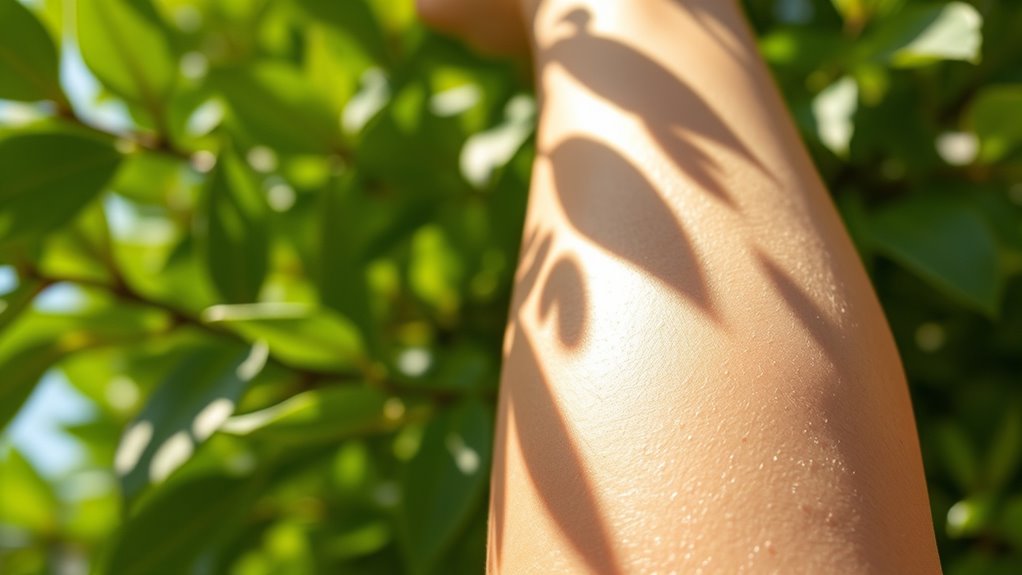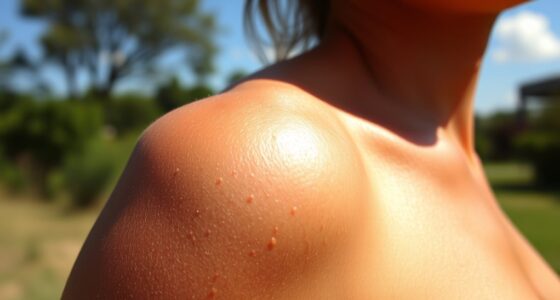A base tan might seem like a shield, but it only offers minimal protection—roughly SPF 3 or 4—and falsely suggests you’re safe from UV damage. In reality, a tan signals prior skin injury and does little to prevent sunburn or skin cancer. Relying on a tan is risky because it masks the true dangers of UV exposure, which can lead to long-term skin harm. Discover more about the truth behind tanning and sun safety.
Key Takeaways
- A base tan offers minimal SPF, roughly 3-4, providing little real protection against UV rays.
- Tanning indicates prior skin damage; it does not shield or prevent future UV harm.
- Relying on a tan for protection is risky and can accelerate skin aging and increase cancer risk.
- Proper sun safety involves using broad-spectrum sunscreen, protective clothing, and seeking shade, not tanning.
- No tan is truly safe; prevention through protection is the best strategy against UV damage.

Many people believe that getting a base tan can protect them from sunburn and reduce skin damage, but is that really true? This common misconception often leads folks to think they’re safe in the sun because they’ve already tanned. The reality is, a base tan isn’t a shield against the harmful effects of UV radiation. Instead, it signals that your skin has already been exposed to UV rays, which can cause skin damage at the cellular level. Relying on a tan as a form of protection is risky and promotes dangerous behavior under the false impression that it’s a safe strategy.
Tanning misconceptions like this can be dangerous because they mask the real risks involved with sun exposure. Many assume that a tan is a sign of healthy skin, but in truth, it’s your skin’s way of responding to UV damage. When UV rays hit your skin, they trigger increased melanin production—your skin’s natural pigment—which results in a tan. However, this process doesn’t mean your skin is protected or that the damage has stopped. It’s a sign that your skin has been harmed, and further exposure can lead to more skin damage, including premature aging, dark spots, and even skin cancer.
You need to understand that a base tan offers very minimal protection—roughly SPF 3 or 4—meaning it provides no meaningful defense against UV rays. The idea that you can “build up” a tan before a vacation or outdoor activity to avoid burning is flawed. Instead of protecting your skin, it accelerates damage and increases your risk of long-term skin issues. Many people fall into the trap of believing that they can control their sun exposure through tanning, but this misconception ignores the cumulative damage that adds up over time.
Getting a base tan may seem like a clever way to prepare your skin, but it’s actually a dangerous myth. Skin damage from UV exposure is cumulative, and even a slight tan indicates underlying harm. The safer approach is to use broad-spectrum sunscreen, wear protective clothing, seek shade, and avoid peak sun hours, rather than trying to tan beforehand. Remember, no tan is truly safe, and embracing your natural skin tone with proper protection is the best way to keep your skin healthy. Don’t let misconceptions convince you that a tan is a sign of resilience—it’s a sign of damage.
Additionally, modern home theatre projectors can provide high-quality images that make understanding the risks of sun exposure more engaging through visual education.
Frequently Asked Questions
Can a Base Tan Prevent Skin Cancer Effectively?
A base tan does not effectively prevent skin cancer. Tanning myths often suggest that a base tan offers protection, but it actually causes skin damage. The color you get from a base tan is a sign of skin injury, not safety. Relying on a base tan gives a false sense of security and increases the risk of skin cancer. Protect your skin by avoiding UV exposure and using sunscreen instead.
How Does a Base Tan Compare to Sunscreen Protection?
A base tan isn’t as effective as sunscreen protection, and tanning misconceptions can lead you to believe it’s safer. While a base tan might offer minimal protection, it doesn’t block UV rays enough to prevent skin damage or skin safety issues. Sunscreen with proper SPF remains your best defense, reducing risks of sunburn and skin cancer. Relying on a base tan can give false confidence, so always prioritize protective measures.
Is Indoor Tanning Safe for Achieving a Base Tan?
Indoor tanning is not safe for achieving a base tan, as it perpetuates tanning myths that a tan protects your skin. UV exposure from indoor tanning damages your skin and raises your risk of skin health issues, including skin cancer. Relying on a base tan for protection is misleading and dangerous. Instead, protect your skin by using broad-spectrum sunscreen and avoiding unnecessary UV exposure to stay safe.
What Are the Long-Term Skin Effects of Base Tanning?
A base tan is like a false shield—giving you a false sense of security. In the long run, it can speed up skin aging and cause pigmentation changes that are hard to reverse. UV exposure from tanning damages collagen and elastin, leading to wrinkles and sagging. So, while it might seem like a quick fix, you’re actually risking more skin issues down the line.
Can a Base Tan Improve Vitamin D Levels Naturally?
A base tan can slightly boost your vitamin D production because skin pigmentation influences how your body synthesizes this nutrient from sunlight. When your skin is darker, it may need more sun exposure to produce the same vitamin D levels as lighter skin. However, relying on a base tan isn’t a safe or effective method for increasing vitamin D, as overexposure raises skin cancer risks. Consider supplements or foods for safer vitamin D intake.
Conclusion
A base tan may seem like a shield, a safeguard against sunburns, a barrier to skin damage. But don’t be fooled—it’s not a guarantee of safety, nor a license to ignore protection. Think of it as a thin layer of armor that can crack, a fleeting shield that offers little real defense. Remember, true protection comes from seeking shade, wearing sunscreen, and knowing your limits—because your skin’s health is worth more than a fleeting tan.









